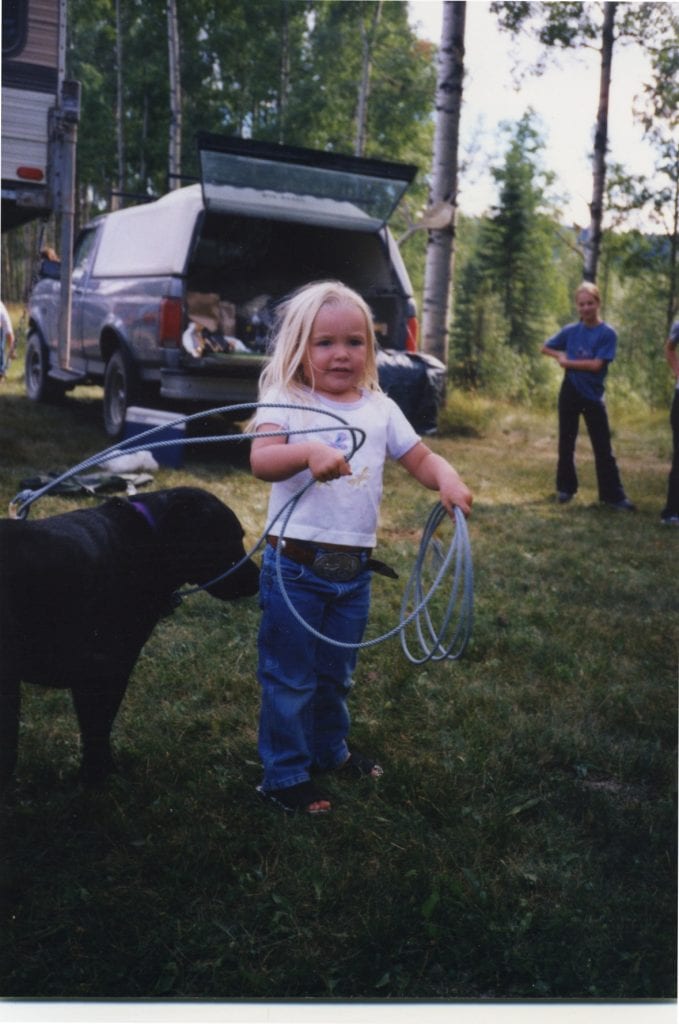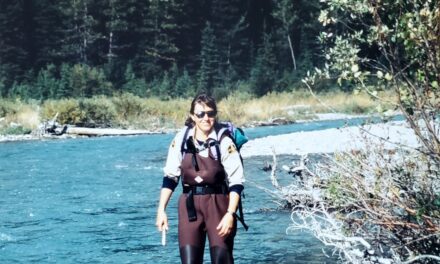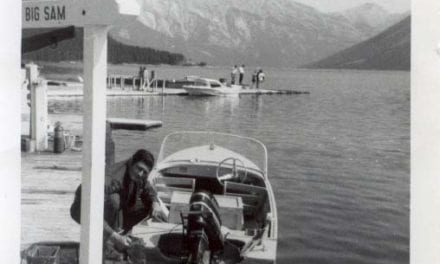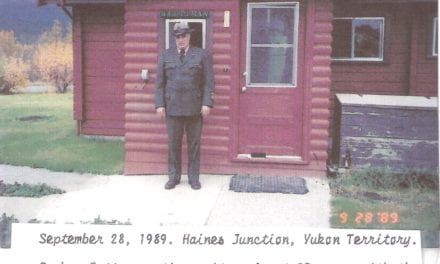Rod – What about hunting on the ranch?
Rob: It’s been pretty stable. It has never really changed too much. It has always been a zone for trophy elk. There is some sheep hunting but that does not really affect the ranch. The elk hunting is the main hunting on the ranch. The ranch is a popular elk hunting area mainly, I think, because of its accessibility. One thing I’ve noticed is that the real nice bull elk do not last long. They get that 6th tine and they are gone. There’s has been a lot of controversy over that 6-point rule. There used to be an archery season as well as a rifle season. The rifle season was always on draw and anybody could pick up an archery tag. Some of these guys were coming in every year with their bow and arrows and taking out the elk before the hunting season started for rifle. So there was a lot of controversy over that. They (the Province) has kind of rectified that now. But hunting really doesn’t affect us at the ranch other than the fact that the odd hunter thinks he bought the place when he bought his licence and he isn’t adverse to cutting fences and hunting in the posted ‘no hunting’ areas. They are a minority. Most of the hunters are good.
Rod Wallace: Most elk are on a draw now too for the bulls?
Rob: Both archery and rifle hunters have been grouped together now. They have lowered the quota on the number of bulls they are taking.
Rod Wallace: How many people stage from there to sheep hunt?
Rob: It varies from year to year. There are only a couple of outfitters that stage out of the Bighorn Campground anymore. It’s not a draw (for a licence) on Bighorn Sheep, so people can just buy a tag so it’s mostly just local hunters that come out. It can vary from year to year. A hunter managed to shoot the ‘governor general’ ram just below the water reservoir two years ago. So that got quite a bit of attention and so there is more people coming in there. I would not recommend it for great sheep hunting as there are a lot of marginal rams. The elk, as soon as they get legal, they get shot. It might be better if they let them go (without a hunt) for a couple of years, there’d be a lot more bigger animals.
Rod Wallace: So they are hunting area between the park and the ranch, right?
Rob: Yes, but mostly to the north and south of the ranch – there’s Sheep Mountain and “The Hat” to the north of us. On the south side of the river the hunters go up on what they call the “Sheep Cliffs”. They are the most popular areas for sheep.
Rod Wallace: Is there other areas that hunters can stage from to get to where the sheep are?
Rob: No, not really, as the ranch is the most practical spot to stage from. There will be people (hunters) that go up the Panther River and also up the Clearwater to the north of the ranch. Some of the Clearwater hunters stage out of the Bighorn Campground. They will drive in and park their vehicles at the campground staging area and ride into the Clearwater and disappear for a while. We don’t have to deal with them much. The sheep hunters are not much of an issue. Just their vehicles are left parked (legally) on the ranch while they are gone.
Rod Wallace: You mentioned the researchers. There have been all kinds of researchers there over the time that you have been there. Were they familiar with horses?
Rob: It depends on what their project is. Quite a few of them have been interested in horses and I think it has been beneficial. There was some controversy with some of the people in the parks who seemed to be a little resentful of the researchers using horses. However, I think it has been a really big plus for the horse program. The researchers found out how valuable the horses can be to their project. For instance, there is a project that they are just finishing up where they have been catching and collaring elk. Every since I have been at the ranch there has been studies that involve capturing the elk. The elk always suffered a lot of stress when they were using helicopters or traps. In recent winters they have been tranquilizing elk from horseback and the stress level for the elk has dropped substantially. Veterinarians from the Calgary Zoo and the other veterinarians who monitor the elk while they are being processed are finding that the heart rates of the elk are staying pretty normal. Soon afterwards they get up and go back to grazing. The use of horses has been a real positive thing. It is not getting much publication but more interest is starting to show. The scientists in the park are really starting to catch on to the use of the horses which is really, really good. As far as I am concerned anyone who uses horses is a friend of mine.
Rod: That is a great thing to justify having the horses.
Rob: And the ranch itself is such an important ecological area I think it would be a waste if they were not doing some studies out there. I am very supportive of it. It is a good way for Parks Canada to help out the Universities.
Rod Wallace: So, you must learn a lot from what they are doing as far as research and study results.
Rob: Yes, we benefit from what they are studying. It’s a win-win situation I think.
Rod Wallace: Were you involved with any haying operations that were done there on the ranch?
Rob: No. That was all done in the past. I don’t know when they quit haying at the ranch. It was not possible to put up any hay during the time I’ve been there due to the elk (grazing) and I don’t think it would be all that practical today because of the quantity of hay that is needed. I am not sure how practical it really ever was. It would require pretty wet years to get the grass growth and the grass would need to be fenced off. I don’t think it produced a huge quantity of hay. Also, there’s not that much ground that is suitable for haying. Fred Dixon did cultivate some. (Nellie Murphy wrote in her memoirs that haying took place every summer in the years that they were at the ranch. The Murphy’s seeded brome, crested wheat grass and oats. With the assistance of help sent out from Banff they harvested enough hay to feed the horses for the winter. They always harvested the tame grass first then the bunch grass. They observed that the horses fared better on the bunch grass. Cliff Murphy worked at the ranch and as a park warden from 1929 to 1948. He married Nellie Reviere in and she moved to the ranch in 1933.) What we call the “Jingle Pasture and the area near the present hay shed were cultivated I believe. He probably ploughed it up and seeded it. There is some old machinery from that day still kicking around out there.
Rod Wallace: Has it pretty much come back to wild grass now? Is there much evidence of tame grass any more?
Rob: Not really. I don’t know much about the results of the grass studies. I got so I can recognize some of these grasses that are not native, but the native grasses have pretty much taken over. The one pretty interesting thing that Mark Hebblewhite
found from results of his studies at the Ya Ha Tinda is that the horses actually prove beneficial to the ecology of the ranch. Where the horses graze the heaviest the nitrogen in the soil is much better and so the grasses are much better. This has also been the case in areas like the Serengeti Plains. The grasses need to be grazed in order to stay healthy. When previous studies fenced off exclosures in order to study rough fescue, they have now found that the fenced exclosures have been taken over by brush. So it seems that the grazers help to keep the brush down. If it doesn’t get grazed the cinquefoil and scrub willow take over. It is actually healthier with the horses grazing it. (Mark Hebblewhite is currently an Assistant Professor in the Wildlife Biology Program at the University of Montana in Missoula, Montana.)
Marie: Rob and Sue’s daughters Shelby and Jordan have joined us. Shelby was a year old when she moved to the ranch and had to be home schooled for a while. Can we ask you about schooling?
Shelby: I was home schooled for Grades One and Two.
Marie: Sue, how was home schooling?
Sue: Some days were better than others. We made a plan that we started school at a certain time, therefore we could end at a certain time, and we started usually after she got back from doing chores with Rob.
Shelby: It was 9 am to 12 Noon.
Sue: We were usually done school by lunchtime and then we rode our horses all afternoon. Home schooling was good and it was also hard. I had to be the ‘teacher’ and not ‘mom’; and it was hard for Shelby to see me as the ‘teacher’ and not ‘mom’.
Marie: When you were homeschooling did you have to come in to the Sundre school for tests or any thing like that?
Sue: Not really, but I did bring her in for activities to get her used to a bit of a school environment. The homeschool parents and kids would meet at one of the halls and there might be 10 other kids there. Just so she could see what it was kind of like. I brought her in to take swimming lessons as well. Shelby was maybe 3 or 4 years old and the swimming teacher was in the water and she had all the little kids lined up at the side of the pool. I could tell that Shelby shaking with excitement to get into the water. Finally she just jumped in and sunk right to the bottom. The teacher pulled her up and the first thing out of Shelby’s mouth was “I don’t know how to swim!”
Rob: She’s also got a pretty good wildlife story behind her, but the Statute of Limitations won out on that one. She was always trying to catch a sheep when they came into the yard to lick at the salt block. She had got her own little rope and I had watched her throw a rope a few times and wasn’t too concerned that she would actually catch anything. There was a young fellow working at the ranch on a term contract. He was starting a colt in the round pen and I was just taking my colt out for the first ride out of the round pen. I was riding towards the gate to the ranch yard, and suddenly I hear a commotion. I look towards our house and there is sheep going in every direction. It turned out that Shelby had roped a yearling sheep somehow. It was bouncing around on the rope and jumping about four feet in the air and dragging her around the yard. She wasn’t about to let it go and she was screaming at the top of her lungs, “Mom, bring another rope!” Anyways, the other guy was just getting on his colt about this time and the colt got scared and started to buck and ended up bucking him off. My colt was trying to run away but I managed to get him under control. I tied up the colt and I ran back up there and got a hold of this sheep and let it go. Shelby wouldn’t talk to me for about a week. Later, Shelby said, “I not going to try that again until I am at least 9 years old”.
Rob: Somewhere there is probably a sheep running around out there on the mountain with quite a complex! (laughs)
Rod Wallace: (to Shelby) How long did you have to hang on?
Shelby: I don’t know. I actually wanted to ride the sheep because I had gone to the Kids’ Rodeo and the sheep I had drawn to ride had just stood there and didn’t do anything. So, I wanted to try one that would run! So I thought I’d try one at the ranch.

Shelby practicing her roping on the dog.
Sue: When I had to do the tours of the ranch buildings we’d get to the Quonset barn (Baby Barn) and Shelby would lock us in the barn for about half an hour at a time. She wouldn’t open the doors at all. The people always thought that it was funny but I didn’t
Rob: Yeah, she had some good adventures.
Marie: (to Shelby) You must have some memories about riding with your Mom.
Shelby: I remember few rides. Mostly just that my horse wanted to go back to the barn when I first got him. This was my first horse. His name was “Fishhead Fish”.
Marie: How did you come up with that name?
Shelby: When my Dad was shoeing horses that was the name he called the horses when they would not behave.
Rob: I was trying to be nice without using my more colourful language. It didn’t always work.
Sue: Shelby changed the horse’s name from “Champ” to “Fishead”.
Sue: It was always interesting. We’d go out every afternoon to do things. Often times we’d meet up with Marie and we’d go down to the barns. Rob and Dick would sometimes be shoeing and there might be off-colour words coming out these guys at times. So, one day, we are talking outside of the barn and Shelby had disappeared and the dog had also disappeared. I went into the barn and found Shelby. There she was holding the dog’s leg up, like a horse being shod, and she had the shaping hammer and she was yelling at the dog, “Hold still you S.O.B.” I thought, what the heck is she doing and the dog was looking at me with a “Help me!” look.
Marie : Sometimes kids have to make their own entertainment out at the ranch.
Rob: I remember, every once in a while the stud (Arrow) would be just displaying himself (his privates) with everything hanging down. Of course Shelby, who was about 3 years old, wanted to know what this was all about. Sue didn’t quite know how to explain it so she told Shelby to ask me. I was busy shoeing or something and Shelby asked what was going on with Arrow and I told just her that the stud’s guts were falling out. So anyways, there was the little museum that Marie had put together out there and it is right beside the stud’s pen. So when people were finished touring the museum with Sue and Shelby the people would come out of the door and the stud would be standing there and Shelby would tell the people the stud’s guts are falling out. (laughs)
Rod Wallace: You mentioned shoeing. Did you do a lot of the shoeing initially?
Rob: Yeah, you are responsible for the shoeing the colts that you are training. I went to Olds College and I have been a certified farrier for over 30 years. I have done a lot of shoeing all my life. And still do quite a bit.




Recent Comments